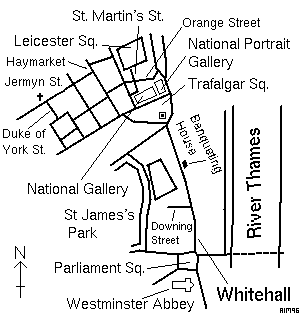A Newtonian walk from Westminster to Jermyn St
 This page describes a route through a central part of London with many
Newtonian places of interest. The total distance is just over a mile (2 km)
and it should take about half an hour to walk without stopping. I would
advise getting a proper street map if you don't know this area, but this
sketch map might be enough. Descriptions of individual places are not
included in the text and usually have separate pages in the
London section of
Newtonia.
This page describes a route through a central part of London with many
Newtonian places of interest. The total distance is just over a mile (2 km)
and it should take about half an hour to walk without stopping. I would
advise getting a proper street map if you don't know this area, but this
sketch map might be enough. Descriptions of individual places are not
included in the text and usually have separate pages in the
London section of
Newtonia.
The walk starts in Parliament Square. Westminster underground station (Circle and District lines) is near the east side of the square. South east of the square are the Houses of Parliament, where Newton was twice a member for Cambridge University. To the south is Westminster Abbey where Newton is buried. The entrance is at the West Door.
The walk continues northwards along Whitehall, past Downing Street (the London residence of the Prime Minister) and the seventeenth century Banqueting House. At the end of Whitehall is Nelson's Column and Trafalgar Square. On the north side is the National Gallery and to the east of this is the smaller National Portrait Gallery, which has the 1702 Kneller portrait of Newton.
The next part of the walk is more complicated. Turning left out of the door of the National Portrait Gallery, follow the side of the building past a small lawn with railings and a statue of Henry Irving. You should see an L-shaped lane called Orange Street. Follow this street westwards past the Orange Street Congregational Church and turn right into St Martin's Street where Newton lived from 1710.
At the end of the street is Leicester Square, surrounded by cinemas and fast food restaurants. There is a bust of Newton just inside the south west gate of the small park in the centre.
Leave the square westwards, past the Swiss Centre in the north west corner. Cross Whitcombe Street and follow Coventry Street to Haymarket. From the corner you should be able to see Jermyn Street to the south on the opposite side of Haymarket. Follow Jermyn Street westwards, crossing Regent Street. At this point Jermyn Street is thick with gentleman's tailors and shirtmakers. Opposite the junction with Duke of York Street, is St. James's church and just beyond are Nos. 87 and 88 where Newton lived between 1696 and 1710.
© 1994-1999 Andrew McNab. Back to newton.org.uk